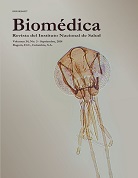Trends in antibiotic resistance in Medellín and municipalities of the Metropolitan Area between 2007 and 2012: Results of six years of surveillance
Abstract
Introduction: Bacterial resistance is a global phenomenon, but it presents geographic and temporal variations; this is the importance of local surveillance programs.
Objective: To determine trends in antibiotic resistance in hospitals between 2007 and 2012 in Medellín and its Metropolitan Area.
Materials and methods: Percentages of antibiotic resistance between 2007 and 2012 in 22 institutions were obtained using WHONET 5.6 program. For interpretation of susceptibility results, CLSI standards
of 2009 and 2012 were used. Using the Epi-Info 6.04 program a trends analysis of antibiotic resistance was done using the chi-square for linear trend with a confidence level of 95%, a value of p≤0.05 was considered significant.
Results: In six years of surveillance of antibiotic resistance we found a decrease of oxacillin resistance in Staphylococcus aureus (p=0.0006) and an increase of vancomycin resistance in Enterococcus faecium (p=0.0000). In Escherichia coli and Serratia marcescens an increase of resistance to ceftazidime was found, in contrast to a decrease in Klebsiella pneumoniae (p=0.0000) and Enterobacter cloacae (p=0.058). K. pneumoniae, S. marcescens and E. cloacae showed an increase of carbapenem resistance in contrast to a reduction of carbapenem resistance in Pseudomonas aeruginosa and Acinetobacter baumannii.
Conclusions: The resistance surveillance identified important findings as the emergence of E. faecium resistant to vancomycin and carbapenem-resistant Enterobacteriaceae. It is essential to determine the antibiotic use in the region to establish their influence on the resistance profiles, as well as ensuring the quality of information and microbiological procedures in the microbiology laboratories.
Downloads
Some similar items:
- Karen Melissa Ordóñez, Odismar Andrea Hernández, Jorge Alberto Cortés, María José López, Gladys Alfonso, Alejandro Junca, Left-sided infective endocarditis caused by Pseudomonas aeruginosa treated medically , Biomedica: Vol. 30 No. 2 (2010)
- Isabel Mayorga-Fayad, Gloria I. Lafaurie, Adolfo Contreras, Diana M. Castillo, Alexandra Barón, María del Rosario Aya, Subgingival microbiota in chronic and aggressive periodontitis in Bogotá, Colombia: an epidemiological approach , Biomedica: Vol. 27 No. 1 (2007)
- Jessika Consuegra, Sonia Jakeline Gutiérrez, Adriana Jaramillo, Ignacio Sanz, Gilberto Olave, Jorge Enrique Soto, Carlos Valencia, Adolfo Contreras, Enteric Gram negative rods and unfermented of glucose bacteria in patients with peri-implant disease , Biomedica: Vol. 31 No. 1 (2011)
- Andrés Leonardo González, Aura Lucía Leal, Jorge Alberto Cortés, Ricardo Sánchez, Liliana Isabel Barrero, Juan Sebastián Castillo, Carlos Arturo Álvarez, Effect of adequate initial antimicrobial therapy on mortality in critical patients with Pseudomonas aeruginosa bacteremia , Biomedica: Vol. 34 (2014): Abril, Suplemento 1, Resistencia bacteriana
- Sandra Yamile Saavedra, Carolina Duarte, María Nilse González, María Elena Realpe, Characterization of isolates of carbapenemase-producing Pseudomonas aeruginosa from seven Colombian provinces , Biomedica: Vol. 34 (2014): Abril, Suplemento 1, Resistencia bacteriana
- Leidy González, Jorge Alberto Cortés, Systematic review of antimicrobial resistance in Enterobacteriaceae isolates from Colombian hospitals , Biomedica: Vol. 34 No. 2 (2014)
- Verônica Dias-Gonçalves, Françoise Bohrer-Lengruber, Bianca Oliveira-Fonseca, Renata Meirelles Santos-Pereira, Luis Dione Barbosa de Melo, Ulisses Gazos-Lopes, Alexandre Ribeiro-Bello, José Augusto Adler-Pereira, Detection and characterization of multidrug-resistant enterobacteria bearing aminoglycoside-modifying gene in a university hospital at Rio de Janeiro, Brazil, along three decades , Biomedica: Vol. 35 No. 1 (2015)
- Sara Catalina Penagos, Sebastián Gómez, Pablo Villa, Santiago Estrada, Carlos Andrés Agudelo, Osteomyelitis due to Yokenella regensburgei following craniotomy in an immunocompetent patient , Biomedica: Vol. 35 No. 4 (2015)
- Sandra Liliana Valderrama, Pedro Felipe González, María Alejandra Caro, Natalia Ardila, Beatriz Ariza, Fabián Gil, Carlos Álvarez, Risk factors for hospital-acquired bacteremia due to carbapenem-resistant Pseudomonas aeruginosa in a Colombian hospital , Biomedica: Vol. 36 (2016): Suplemento 1, Microbiología médica
- Laura Cristina Nocua-Báez, Jorge Alberto Cortés, Aura Lucía Leal, Gerson Fitzgerald Arias, María Victoria Ovalle-Guerro, Sandra Yamile Saavedra-Rojas, Giancarlo Buitrago, Javier Antonio Escobar-Pérez, Betsy Castro-Cardozo, Antimicrobial susceptibility profile in urinary pathogens causing community-acquired infections in diabetic patients in Colombia , Biomedica: Vol. 37 No. 3 (2017)
| Article metrics | |
|---|---|
| Abstract views | |
| Galley vies | |
| PDF Views | |
| HTML views | |
| Other views | |


























